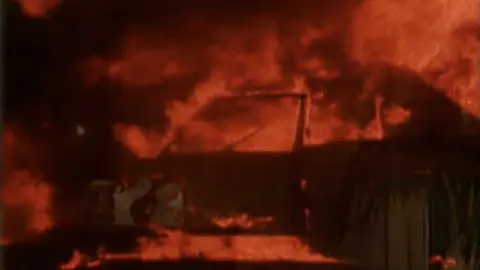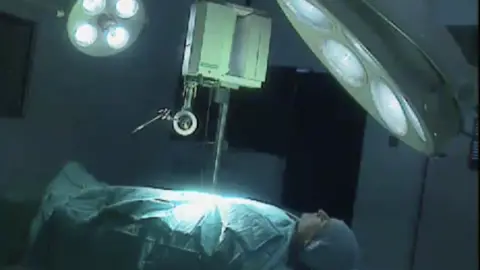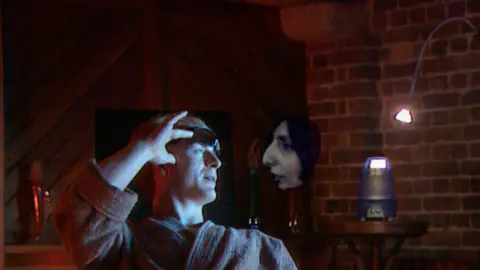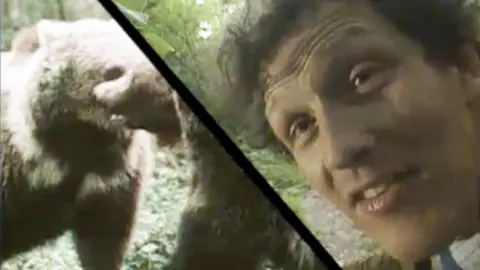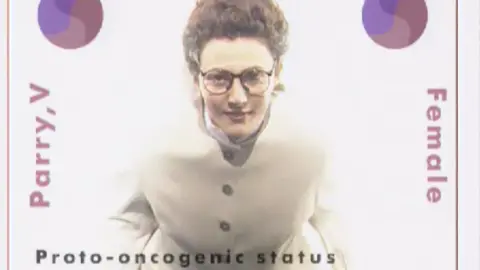
Tomorrow’s World was published in the year 2025.
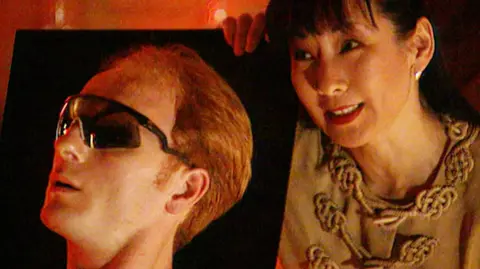
This fictional 2025 couple, along with the man’s ‘VR headset’, featured in the Tomorrow’s World episode in 1995.
In 1995, the BBC’s Tomorrow’s World programme decided to predict what the world would look like 30 years later, in 2025.
The show, which is no longer broadcast, featured one of the most famous scientists of the age, Prof Stephen Hawking, who predicted: “By 2025 we can expect big changes. “
The programme team agreed, suggesting a raft of world-shaking innovations from hologram surgery to space junk gel.
So, with the help of some experts – and the benefit of three decades of hindsight – let’s take a look at how much of today’s world that Tomorrow’s World successfully anticipated.
The ‘Cyberspace Riots’ of 2005
The programme predicted there would be riots after financial markets “succumb to viral terrorism”.
In 1995, the world wide web was really taking off – a development Tomorrow’s World thought would bring future trouble.
They predicted “business barons” and banks would take control of the internet by 2000, establishing a “supernet” which they restricted access to.
That, in turn, would prompt hacks, viruses and even riots.
Tomorrow’s World in 1995 predicted riots would happen after the creation of the “supernet”
Verdict – The internet has remained – mostly – open, and there have been no riots but there is little doubt the actions of hackers have caused misery for many people.
One thing the programme didn’t predict was the role of the nation state hackers like North Korea, expertly told in the BBC’s Lazarus Heist podcast.
Cybersecurity is hugely important for governments and companies, and people who are suspicious of banks have championed cryptocurrencies like Bitcoin.
Asteroid mining and space junk gel
Tomorrow’s World predicted the rise of asteroid mining, and the death of an astronaut from space junk
The programme speculated space mining would become a lucrative industry, with companies excavating asteroids near Earth for precious metals.
The show also suggested space junk would become such a problem it would not be safe for astronauts. Tomorrow’s World predicted the rise of asteroid mining, and the death of an astronaut from space junk.
The programme speculated that space mining would become a lucrative industry with companies excavating asteroids near Earth for precious metals.
The show also suggested that space debris would become such a problem it wouldn’t be safe for astronauts. There is no super-foam gel, and the space junk problem is acute. There is also no space mining industry – but that could change.
Futurist Tom Cheesewright is an optimist about mining beyond our planet.
“The potential riches are unfathomable and the technology is entirely within our grasp,” he said.
The super surgeons and their robots
Tomorrow’s World thought patients would be operated on by robots that were remotely operated by a surgeon from a far-off location
Tomorrow’s World predicted by 2004, a law would be passed for all UK hospitals to publish a league table of surgeon success rates. The top surgeons would become so popular, and so well paid, it would make no sense for them to travel to patients.
Instead, patient holograms would be sent to them and the surgeon would operate using “spacial gloves”. At the patient’s end, a robot would perfectly mimic the movements of the surgeon.
Verdict – They didn’t get it exactly right but robots are helping with surgeries.
A smart speaker with a floating head
Alexa? Siri? Google? The programme showed a man from the future, his wife and young girl, all wearing a VR headset. They were in what appeared to be a modern-day London. She encourages him to take another holiday via a “shuttle to Bangalore” – which would only take 40 minutes. She encourages him to take another holiday via a “shuttle to Bangalore” – which would only take 40 minutes.
Verdict – Ultra-fast travel feels as far away as ever, but holograms, smart speakers and VR headsets are becoming ever more prevalent.
Banking using a microchip in your arm
How do you feel about withdrawing some money using a chip implanted in your arm?
Elsewhere in the programme, we were given a vision of the future of banking.
It featured a woman going to a bank, complaining there were no humans, and then withdrawing 100 “Euro marks.” The bank scans a microchip in her arm and gives her money. And though paying via microchips inside the human body is a reality, other technologies – mainly fingerprint and face scanning – are much more widely used.
In 1995, Tomorrow’s World offered a vision of self-driving cars and the failure of electric vehicles by 2025
Memories from the presenters
Getty Images
Monty Don is a familiar face to many who enjoy gardening programmes
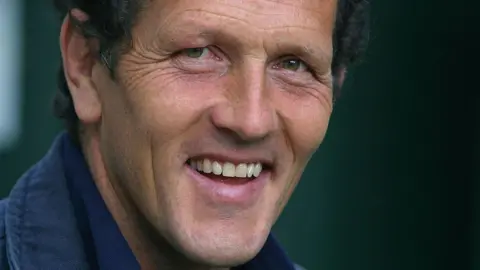
Reflecting on it now, he told BBC News that his part of the programme was “utopian” and “naive”. He is happy that the younger generation is “much more aware of climate change”. He believes that people will grow more food themselves by 2055. “
Monty Don talking about the reintroduction of brown bears in the 1995 programme.
Vivienne Parry was another presenter on the prediction show, and fronted a section about medicine.
She fondly remembers filming it – and the rather limited visual effects of the day. “I had no choice but to remain absolutely still. I had on a pair of glasses with a small camera attached. The glasses were stuck to my face by a large blob black sticky stuff.
It was a very hot day and the black sticky stuff began to drip down my face. I could not move. “Someone from make-up brought along a long cane that had cotton wool at the end. “
Vivienne has been involved with Genomics England since 2013, and highlights that some of the predictions from the 1995 Tomorrow’s World about genomic sequencing have come true, as she works on a research study to help diagnose and treat genetic conditions.
Can you see the black blob? While filming this sequence, Vivienne Parry and the make-up team had to get creative
So what could the world look like in 2055?
Futurist Tracey Follows thought the 1995 programme got a lot of big ideas right, but missed two of the biggest themes of the last 30 years – the spread of big tech and social media.
By 2055, she thinks many people will be “cognitively connected” – a hive mind of humans and technology via servers, which will help in the sharing of ideas.
“Brainstorming will literally be brainstorming, where you can share ideas by thinking them. Tom Cheesewright believes that materials science and bioengineering will be the two most exciting developments in the next 30 year.
In materials, the creation of devices that are even stronger, lighter and thinner could change the world, while bioengineering – married with tight regulation – has the power to transform medicine and tackle “some of the biggest challenges humanity faces – decarbonisation, clean water, food”.
So what do you think the world will look like in 30 years?
Whatever your answers, it would be wise to listen to what Prof Hawking said to Tomorrow’s World three decades ago. What do you think the world will look like in 30 years?
Whatever your answers, it would be wise to listen to what Prof Hawking said on Tomorrow’s World three decades ago. We can be certain that the changes will be drastic and not what we expected. “


